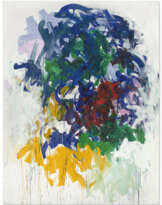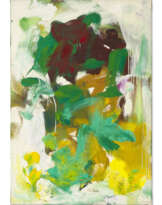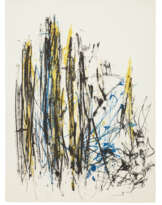ID 949715
Lot 166 | JOAN MITCHELL (1925-1992)
Estimate value
$ 3 000 000 – 5 000 000
Untitled
signed, dedicated and dated 'J. Mitchell 59 A Maurice with love Joan' (lower right); signed again and dated again 'Mitchell 59' (on the reverse)
oil on canvas
45 1/2 x 34 7/8 in. (115.5 x 88.5 cm.)
Painted in 1959.
Provenance
Maurice Lefebvre-Foinet, Paris, 1959, gift of the artist
Lefebvre-Foinet Estate, Paris
Their sale; Christie's, Paris, 1 December 2009, lot 41
Galerie Brimaud, Paris
Acquired from the above by the present owner, 2010
Special notice
On occasion, Christie's has a direct financial interest in the outcome of the sale of certain lots consigned for sale. This will usually be where it has guaranteed to the Seller that whatever the outcome of the auction, the Seller will receive a minimum sale price for the work. This is known as a minimum price guarantee. Where Christie's has provided a Minimum Price Guarantee it is at risk of making a loss, which can be significant, if the lot fails to sell. Christie's therefore sometimes chooses to share that risk with a third party. In such cases the third party agrees prior to the auction to place an irrevocable written bid on the lot. The third party is therefore committed to bidding on the lot and, even if there are no other bids, buying the lot at the level of the written bid unless there are any higher bids. In doing so, the third party takes on all or part of the risk of the lot not being sold. If the lot is not sold, the third party may incur a loss. The third party will be remunerated in exchange for accepting this risk based on a fixed fee if the third party is the successful bidder or on the final hammer price in the event that the third party is not the successful bidder. The third party may also bid for the lot above the written bid. Where it does so, and is the successful bidder, the fixed fee for taking on the guarantee risk may be netted against the final purchase price.
Third party guarantors are required by us to disclose to anyone they are advising their financial interest in any lots they are guaranteeing. However, for the avoidance of any doubt, if you are advised by or bidding through an agent on a lot identified as being subject to a third party guarantee you should always ask your agent to confirm whether or not he or she has a financial interest in relation to the lot.
Post lot text
In the Fall of 1959, Joan Mitchell settled permanently into an airy and spacious studio on the top floor of 10 rue Frémicourt, where she would live for the next nine years. After spending much of the previous decade shuttling back and forth between New York and France, it was in 1959 that Mitchell made the definitive shift to France for good. Looking back, she would describe her Frémicourt paintings as her “boldest paintings” made during “a great violent period” (J. Mitchell, quoted in Joan Mitchell, exh. cat., San Francisco Museum of Modern Art, 2020, p. 105). At this time, Mitchell waged an assault against the canvas, using all manner of techniques, where the paint is flung, dripped, daubed, scraped, spread in thick slabs or thinned down and seeping in thin rivulets. As in Untitled, she used earthy browns, dark, olive greens and wine red, which gather toward the center of the painting as if by centrifugal force. Her wriggling brushwork is like sunlight as it ripples over water, its surface forever shifting in and out of focus. Accentuated by touches of brilliant blue, this web of crisscrossing forms epitomizes the paintings that consumed her at the time, marked by a sense of emotional turbulence but also moments of lyrical joy.
In Untitled, the speed and force with which Mitchell wielded her brush is astonishing at times, as she shakes off the last vestiges of the Abstract Expressionist style of her New York years in favor of a lighter and freer style, albeit not without a fight. She presents us with a barrage of tempestuous brushwork - epitomizing what Linda Nochlin described as her “rage to paint." Especially in the center of the painting, Mitchell creates a wild, visual cacophony of zig-zagging, L-shaped and S-shaped forms. Using a thin brush that she loaded with brilliant, shimmering blue, grassy greens and burgundy, Mitchell attacks the canvas with quick flips of the wrist. There is an almost rhythmic echo amongst these thin wriggles, as they jostle and dance before the eye. Whereas her 1957 paintings were comprised of languorous, horizontal brushstrokes, as in Ladybug (1957; Museum of Modern Art, NY), by the end of 1959, the areas of paint now gather toward the center of the canvas, in thicker, bolder and wider areas of paint, like gathering storm clouds where the heavy impasto and variety of her technique are only outmatched by the gestural force of her brush. These “latticed structures of singular, forceful brushstrokes…operate as lines as well as forms. These compositions begin to contract toward the center, with leggy right-angle marks creating a sense of spiraling or oscillation” (S. Roberts, “Fremicourt,” in Ibid., p. 98).
In 1959, shortly after it was created, Mitchell gifted the present painting to Maurice Lefèbvre-Foinet, the proprietor of one of the oldest and most important art supply shops in Paris. Located in Montparnasse, “L'Établissement Lefèbvre-Foinet” was a favorite haunt of Mitchell’s, along with artists like Alberto Giacometti, Max Ernst, Zao Wou-Ki, Sam Francis and Mitchell’s partner at the time, Jean-Paul Riopelle. An enterprise dating back five generations in Montparnasse, the Lefèbvre-Foinet shop was described by the American artist Dorothea Tanning in her 2001 autobiography, as such: “In their resin-colored, oak-lined shop, behind a window full of immense jars of paintbrushes…[the proprietor appeared] out of the shadowy backroom where packages were made of unpackageable bulks, or from his pocket-sized adjoining office hung with tiny pictures…Monsieur Maurice Lefèbvre-Foinet himself [was] full of jollity for the gents and gallantry for the ladies” (D. Tanning, Between Lives: An Artist and Her World, Evanston, 2001, p. 121).
Dedicated to “Maurice with love,” Untitled masterfully illustrates all of the pictorial developments undertaken at this time. In 2009, Untitled was selected for the artist’s first major retrospective in Italy, which was held at the Palazzo Magnani in Reggio Emilia. Writing in the exhibition catalogue, the curator Sandro Parmiggiani described the painting in glowing terms, declaring that it epitomized "the pictorial language which would become her own: a whirlwind of lines, the result of planetary movements shifting in every direction. [...] The brushstrokes are more fluid and energetic here, becoming thicker to form denser and more distinct surfaces. The weight of the composition becomes more clustered and the song of color fans out with materialistic power, pure pulsating energy into the void, ready to explode" (S. Parmiggiani, Joan Mitchell: La pittura dei Due Mondi / La peinture des Deux Mondes, exh. cat., Palazzo Magnani, Reggio Emilia, 2009 (translated from the original Italian).
The Fall of 1959, in particular, was a heady time for the Chicago-born and newly expatriated artist, marked by leisurely lunches among some of the most important figures of the Parisian postwar intelligentia, including her on-again/off-again partner, Jean-Paul Riopelle, the painter Sam Francis, the poet John Ashbery, the Existentialist author Samuel Beckett (with whom she had an affair in 1959), as well as friends and supporters like Shirley Jaffe and Lawrence Rubin. Long evenings were spent at La Coupole or The Rosebud in Montparnasse, where discussions of poetry, art, literature and politics lingered long into the night. It was around this time that Mitchell developed her practice of painting by electric light, as she’d generally climb the stairs to her studio after dinner. She painted into the wee hours, usually accompanied by jazz or Bach, and check on her development upon waking the next morning.
The late 1950s were a legendary time in Mitchell’s career. In the Fall of 1959, she finally moved into her airy new studio on the rue Frémicourt, which she described as “the closest thing to a loft that Paris could offer” (J. Mitchell, quoted in P. Albers, Joan Mitchell: Lady Painter. A Life, New York, 2011, p. 273). The space was on the top floor of an old warehouse, and Mitchell hired the Polish architect Piotr Kowalski to do the renovations. Skylights allowed in ample natural light, and the studio featured a moveable wall that allowed her to tack up paintings in progress, with plenty of room to display those that were already stretched. She could now regard all of her work in one glimpse, and this gave her a freedom and confidence heretofore not experienced in her work. “With Fremicourt, Mitchell procured stability and a place where she could easily show her work to visitors. [...] She gained the freedom to paint as she wished, at a considerable remove from the pressures of New York” (S. Roberts, op. cit., p. 97).
Within a year of relocating to her new studio, Mitchell had her first solo exhibition in Paris, where the gallerist Lawrence Rubin hoped to give her work the European exposure it so deserved. At the same time, Mitchell was showing regularly at Eleanor Ward’s Stable Gallery in New York, with shows occurring almost annually between 1953 and 1965. Her 1957 exhibition at the Stable Gallery in March was a critical and commercial triumph, with the critic Irving Sandler declaring, “Joan Mitchell continues to be one of America’s most brilliant Action Painters…her art expands in the wake of her generous energy” (I. Sandler, quoted in P. Albers, op. cit., p. 244).
It was during this time that she gradually freed herself from the kind of muscular armature of her New York paintings, made with de Kooning, Pollock and Kline in mind. Slipping away from the abstract paintings that evoked bridges or skyscrapers in favor of sumptuous surfaces where blue, green, purple, orange and red were the dominant colors, heavy with impasto and staggering in the variety and courage of her gestures, Mitchell found her own voice. "As delectable as they are raw," her paintings court chaos with their sweeps of disrupted syntax, surpassing the viewer's ability to process them in a conscious way," Patricia Albers, Mitchell's biographer has written. Indeed, these paintings are a testament to "the artist's all-consuming lover's quarrel with oils," making them "a glorious, visual glossolalia" (P. Albers, op. cit., pp. 286-7).
| Artist: | Joan Mitchell (1926 - 1992) |
|---|---|
| Art style: | Post War Art |
| Auction house category: | Paintings |
| Artist: | Joan Mitchell (1926 - 1992) |
|---|---|
| Art style: | Post War Art |
| Auction house category: | Paintings |
| Address of auction |
CHRISTIE'S 20 Rockefeller Plaza 10020 New York USA | ||||||||||||||
|---|---|---|---|---|---|---|---|---|---|---|---|---|---|---|---|
| Preview |
| ||||||||||||||
| Phone | +1 212 636 2000 | ||||||||||||||
| Fax | +1 212 636 4930 | ||||||||||||||
| Conditions of purchase | Conditions of purchase | ||||||||||||||
| Shipping |
Postal service Courier service pickup by yourself | ||||||||||||||
| Payment methods |
Wire Transfer | ||||||||||||||
| Business hours | Business hours
|














